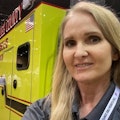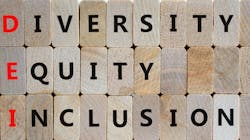Health & Wellness: Building Psychological Safety for Inclusive Firehouses
“Have you started the stock shelf check for the ambulance yet?” asks Jane. “If not, I have an idea to make the team process more efficient.”
“Well, duh, not yet,” replies John. “I’m checking the equipment bags first.”
“Why do you belittle me in that manner when I only asked you a question?” Jane asks. “You don’t seem to have a problem when men ask you questions or have ideas.”
John shrugs his shoulders and replies mockingly, “‘Waaaah. I’m a woman experiencing discrimination.’ You’re imagining things again, Jane.”
Jane answers, “I don’t appreciate the patronizing, so I am hesitant to share my input and ideas.”
John says, “We have a system already that works” and “I heard we’re hiring another one of you. I hope the fire chief divides the women among the shifts to even out the manpower.”
Psychological safety refers to the belief that people feel comfortable expressing their ideas, thoughts and mental health struggles with coworkers without fear of reprisal, taunting or ridicule. The conversation between Jane and John lacks psychological safety for Jane, and John’s replies attempt to make her feel inferior and excluded.
Psychological safety is a social construct that’s developed and maintained by people who are in an organization. This type of inclusion explains people’s different experiences on whether they feel comfortable asking questions and sharing ideas and safe to take risks within their work group. The issue is a concern when firefighters censor themselves and can’t speak what is on their mind, which leads to a loss of inclusion. When this occurs, the team doesn’t experience unique diversity perspectives and doesn’t know when teammates are hurting or experiencing PTSD.
The good news is that fire chiefs and company officers can implement four key strategies to build psychological safety for inclusive firehouses: develop team trust for inclusion, make inclusive decisions, create a climate for interpersonal inclusion and learn from others through inclusion.
Team trust for inclusion
According to Lisa Nishii, who is the chair of international programs in the School of Industrial and Labor Relations of Cornell University, in regard to psychological safety, inclusion is difficult to obtain when trust isn’t in the organization. When there’s a lack of confidence, team members waste time and energy thinking about what they should say and what they shouldn’t say.
Firefighters wonder about the true intentions of their peers when they’re interacting with them. For firefighters, particularly rookies, to speak up in a group setting, they need reassurance that making mishaps along the way is the process of learning and that their peers won’t think less of them. Lack of psychological safety prevents people from learning and growing. They fear reprisal or resentment for saying the wrong thing, asking questions or requesting feedback. This process shouldn’t be seen as a weakness but rather as something that’s expected as a part of learning.
Within the context of diverse teams, firefighters must share expectations about the kind of effect that their unique differences, gifts and contributions can bring to the department. When fire chiefs and company officers value the ideas of different firefighter perspectives and how those perspectives help the department, those chiefs and officers promote psychological safety for people to express their thoughts and feelings. Leaders must promote respect and trust among their peers equally and interrupt actions that inhibit psychological safety.
Peers must trust one another, knowing that when they go to a coworker that person won’t talk or post a negative comment behind their back if there’s an issue. The worst things that leaders can do are to assume that trust naturally develops over time and to neglect their vital role in team cohesiveness.
Fire chiefs and company officers can help to develop trust among team members in several ways. One of the best ways is by performing company drills and team training to help to identify areas that need improvement and areas where accomplishment warrants praise. Another way is for leaders to create a conversation space for team members to engage in storytelling or share personal information. Leaders can ask each team member a set of questions to open dialogue to learn similarities and to engage tales for bonding. Here are three examples: What first sparked your interest in becoming a firefighter? What obstacles did you have to overcome before or during academy training? In what role do you see yourself 10 years from now?
Telling stories about ourselves allows us to be vulnerable, where others have the opportunity to listen and learn things that they didn’t know. This exercise also provides minority firefighters a safe space to talk about their lived experiences, so all firefighters can build empathy and learn about equal access. It’s imperative that leaders explicitly speak about psychological safety and the need to develop trust to care for their team during these discussions.
Inclusive decisions
In groups, people tend to focus on information that’s shared by the majority, which becomes the influence and discredits any unique contributions, usually held from diverse minority members’ thoughts. This psychology phenomenon happens because people prefer to be validated by others rather than risk apprehension of expressing an idea outside of the majority’s beliefs, regardless of whether the idea is correct. When groups have strong social bonds, it’s safer for members to take risks to share ideas and information that might differ from the majority. This bond is why psychological safety is essential for inclusion.
Fire chiefs and company officers must highlight their team members’ similarities to help to build bonds and to reiterate that differences make them stronger and more innovative in decision-making. Building bridges and team bonding makes people more likely to share unique information and to not focus so much on the fear of sharing something that’s outside of the majority’s groupthink.
When departments have diverse members on the team, it brings a multiplicity of perspectives, experiences and ideologies. Engagement of various ideas and viewpoints sometimes brings conflict, but don’t let a little friction stifle making inclusive decisions. It’s a good thing for people to engage in sharing different ideas and perspectives, because this is where learning and innovation occur. Fire chiefs and company officers must remind the team of the expectation that everyone’s input and shared ideas contribute to the final decision.
A climate for inclusion
Fire chiefs and company officers can build an inclusive organizational environment by having a shared meaning of what employees attach to the city’s human resource policies, practices and procedures that they experience. Leaders also can communicate to firefighters about the behaviors that are expected and seen as rewarded, valued and supported within the organization. All firefighters should have shared perceptions about what the policies and procedures communicate about inclusion and about the actions that are viewed as desired and promoted each shift.
Climate is created and maintained through several different mechanisms. The most noticeable is the department’s standard operating procedures manual that supports an inclusive climate, including code of conduct, ethics and the factors that are emphasized in promotional decisions. Fire chiefs and company officers should convey that inclusion is valued and is a priority for departmental harmony through direct and indirect communication.
Cultural norms also shape the climate and behavior that employees create within their team. These norms develop through leadership role-modeling, which communicates to firefighters which attitudes are essential, anticipated and appreciated within the team. For an inclusive climate to exist, conditions must be present for fair treatment and unbiased decision-making, so there is less stereotypical thinking of in-group or out-group dynamics.
Learning from others
Psychological safety is critical for inclusion and learning. For learning to occur, there must be an emphasis on interpersonal sharing for trust-building within inclusive climates.
Fire chiefs and company officers should take the time to develop relationships on a deeper level and form personalized friendships to open communication pathways. When people don’t know each other well or don’t have formed connections, miscommunication conflict can occur. because people assume what the other is thinking. People are less likely to share their ideas, ask for help or stretch themselves to learn something new when they don’t have psychological safety.
Leaders can emphasize incorporating diverse perspectives by building an inclusive culture through trust. When firefighters don’t have psychological safety and sense apprehension because in-groups and out-groups exist, the climate can’t be inclusive for learning.
Sometimes, it isn’t enough to say that we value everyone’s opinion for promoting psychological safety, because diverse personalities exist within the team. Dominant personalities can overpower discussions, and subtle interpersonal dynamics still might silence some voices. Fire chiefs and company officers must take proactive measures and implement various mechanisms to ensure that people contribute their ideas equally uninterrupted by others and that people receive credit for their contributions and ideas.
About the Author

Shara N. Thompson
Shara N. Thompson holds a Master of Human Relations from the University of Oklahoma. She is pursuing a Ph.D. in change leadership at the University of Central Arkansas. Thompson is the first hired female firefighter/paramedic for the Addison, TX, Fire Department and the first female cadet to graduate from Collin College Fire and EMS Academy. A licensed paramedic and graduate of the University of Texas Southwestern Medical Center, she holds a degree in interdisciplinary studies (psychology and sociology) from the University of Texas at Dallas and is a recipient of the Who's Who Among Students in American Universities and Colleges National Leadership Inductee. Thompson holds severa graduate certificates in social sciences, including from Northwestern University and Cornell University.
